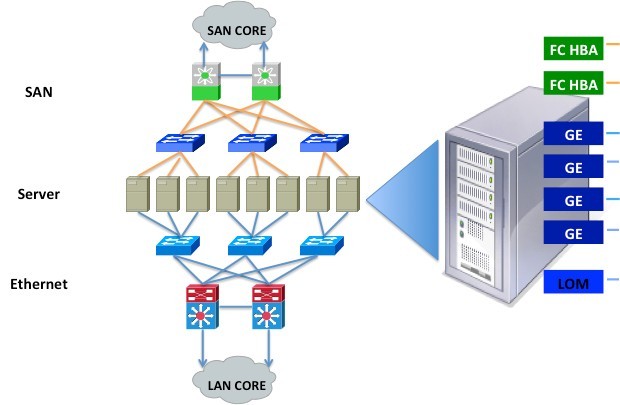Data Center Network
Challenges for data center network
With the gradual application of server virtualization, the following problems need to be resolved for data center network:
Application server exists in the form of a virtual machine (VM) and it is not bundled onto a particular physical server. The network equipment needs to identify VM and apply different security and service quality strategies according to different VMs.
A single physical server may have multiple VMs (10 to 100) and server flows have registered exponential growth. Therefore, network equipment needs to be highly capable of forwarding data and the trunk network shall have sufficient bandwidth.
In order to support the dynamic migration of VM, servers in a cluster need to have two layers connected. The scope of two-layer network is widening and even covers the data center. It is necessary to avoid the impacts arising from such a large-scale two-layer network.
With the sharp increase in the quantity of corporate data center servers, the servers need to be connected to the IP network and also the storage network. Redundancy must also be considered. A single server has numerous I/O board cards that result in continuously increasing power consumption, size, wiring costs and maintenance costs of servers. Meanwhile, maintenance of two sets of network (IP network and storage network) is required. Therefore, it is another challenge to integrate server I/O, IP network and storage network of the data center and reduce the operating and maintenance costs of data centers. Please see the following Figure for the architecture of a traditional data center network.

Uniform data center network solution
In order to support the virtualization of servers, a data center network needs to have the following capabilities: identify VM; differentiate the data transmitted by different VMs and apply relevant strategies through the use of VM flag protocol. A data center network needs to be capable of high-density 10G access and outstanding data forwarding and be able to satisfy the servers’ demands for increasing bandwidth. It shall be capable of horizontal virtualization and L2 channel, i.e. simplify the two-layer network structure through horizontal virtualization (virtualize multiple units of physical equipment into a single unit of logic equipment) and provide cross-data-center two-layer interconnection through L2 channel technology.
The data center network supports FCoE protocol, i.e. the protocol on transmission of stored data via the Ethernet which enables the transmission of IP data and stored data via a uniform Ethernet architecture. To ensure the reliability of stored data, the data center network needs to support lossless Ethernet technology in order to avoid the severe time delays arising from data losses and re-transmission.
Please see the following Figure for uniform data center network solution:

Conclusions:
Server virtualization requires that the data center network should be capable of virtualization and that the data center network should be capable of high-density 10G access and outstanding data forwarding. Integration of IP network and storage network can reduce the server I/O investments and maintenance costs and simplify data center network architecture.
©Guangzhou Xinhua Times Data Systems Co., Ltd. 粤 ICP 备 09119233号-1





